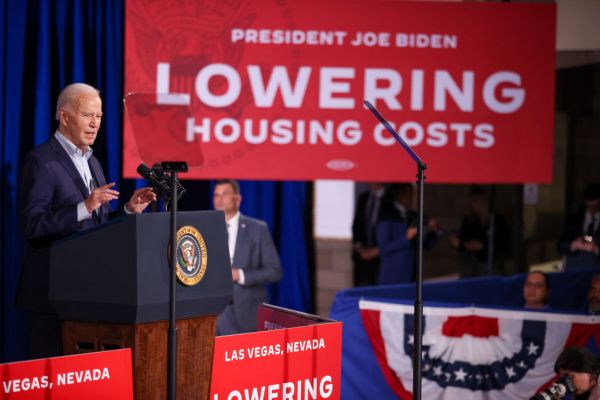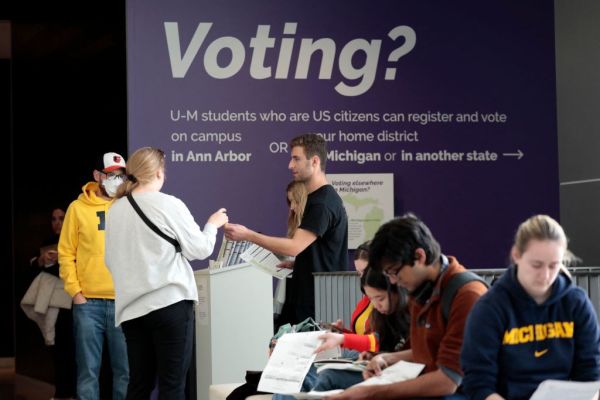We didn’t wait until the race for president was tied in the polls nationally to start including the weekly average of horse race polls in this note, but it sure seems fitting.
Starting this week and for each of the 23 weeks until Election Day, we will be including the averages for the presidential contest, and we begin thusly: Donald Trump: 40.6 percent, Joe Biden: 40.0 percent, Robert F. Kennedy Jr: 11.6 percent.
We couldn’t start sooner because there were not enough high-quality national polls to produce a reliable average and/or the reasonable expectation that new surveys would come along frequently enough to keep track of movement in the race. There has been lots of polling on the race for months, but very little of it good. As we approach Memorial Day and the major party nominees have been long set, we can start.
Our standard is for the five most recent polls that follow strict methodological requirements, typically those conducted by nonpartisan (or bipartisan) pollsters, have appropriate sample sizes, durations, and call a representative mix of cellphones and landlines. Cheapo robo-dial and online polls are worse than nothing and occur with such frequency that they tend to skew any average that includes them.
In future weeks, we will also add an average to track the race for control of the House of Representatives, the so-called “generic ballot,” but it’s still too soon for that. End of summer, maybe.
Now, a couple of quibbles.
First, we don’t elect the president by national popular vote. So what’s the point of tracking the average?
And second, in 2020, an average of good polls tracked within two-tenths of a point to Biden’s total share of the popular vote but understated Trump by more than 3 points. I expect that the polls will understate or overstate one (or both) of the candidates again this time. So if we know that the polls will be wrong, but not by how much or in what direction, again, why bother?
First, on the national average vs. the Electoral College: We simply don’t have enough good swing-state data to produce a consistent average. However, there is a strong correlation between the swing states and the national result.
The swing states are the swing states because they are a little, but not a lot, less Democratic than the country as a whole. Taken together, America is a clear Democratic majority country. But when we get to the states, less so. The states that decide are the ones where Democrats can win, but don’t always.
In 2020, Biden won the national popular vote by 4.5 points, 51.3 percent to 46.8 percent. But in the seven swing states—Arizona, Georgia, Michigan, Nevada, North Carolina, Pennsylvania, and Wisconsin—Biden got 49.6 percent of the vote compared to 48.6 percent for Trump, a margin of just 1 point.
So that means if Biden is tied nationally, he will lose the election. Even if Biden wins the national popular vote by a point or two, he will still probably lose in the Electoral College given the 3 point or 4 point lean of the swing states toward the GOP.
So when you look at the national average, just remember that it’s not enough for Biden to be ahead—he needs to be clearly ahead to really have a shot at keeping his job,
Second, the question of accuracy.
There’s good reason to believe that Trump would, again, be the one underestimated. However, given the persistent dissatisfaction of Democrats with their nominee but the abiding fear and loathing of Trump, I would hardly be shocked to see Biden do better than polls suggest. What the average can tell us, though, is the direction of the race.
The story of the past several weeks has been of Biden bringing home a bunch of Democrats and blue-tinted independents to his bid. Our average will not perfectly forecast the outcome of the election, but it will give you a sense of which way the race is heading, week to week. The topline number matters, but not as much as the arrows that you will see trending up or trending down starting next week.
As for third-party candidates, for now we are including Robert F. Kennedy Jr., who continues to show sturdy numbers in the low-to-mid double digits. We will be tracking his efforts to win a place on state ballots, but for now it seems likely that he will be in the mix in most states and almost all of the swing states.
But that occasions one more caveat: If Kennedy falls short of the viability line—say, 25 percent—you can expect his vote total to come in substantially lower than his final polling average. Voters generally dislike throwing their votes away. So when you look at his average, imagine it as an iceberg of votes that will likely melt. And you can join the campaigns in guessing into which river of support the runoff will flow.
Holy croakano! We welcome your feedback, so please email us with your tips, corrections,
reactions, amplifications, etc. at STIREWALTISMS@THEDISPATCH.COM. If you’d like to be considered for publication, please include your real name and hometown. If you don’t want your comments to be made public, please specify.
STATSHOT
Biden Job Performance
Average approval: 40.0%
Average disapproval: 57.4%
Net score: -17.4 points
Change from one week ago: ↑ 0.4 points
Change from one month ago: ↓ 1.2 points
[Average includes: Quinnipiac: 39% approve-56% disapprove; Marquette Law: 40% approve-60% disapprove; Fox News: 45% approve-55% disapprove; ABC/Ipsos: 35% approve-57% disapprove; CNN: 41% approve-59% disapprove]
General Election
Donald Trump: 40.6%
Joe Biden: 40.0%
Robert F. Kennedy Jr: 11.6%
[Average includes: Marquette Law: Trump 44% - Biden 41% - Kennedy 11%; Quinnipiac: Trump 38% - Biden 41% - Kennedy 14%; Reuters/Ipsos: Trump 40% - Biden 40% - Kennedy 13%; Echelon Insights: Trump 43% - Biden 38% - Kennedy 9%; Fox News: Trump 43% - Biden 40% - Kennedy 11%]
TIME OUT: GOTCHA!
The New Yorker: “Like a lot of fun things, suspense has a bad reputation. Its detractors have long regarded it as a cheap trick, deployed by hacks or sellouts to entertain the masses. In the nineteenth century, when whole classes of overtly suspenseful books began to emerge, including mystery novels and detective fiction, highbrow critics were quick to denounce them as ‘preaching to the nerves’—that is, winning over readers by provoking curiosity and excitement, rather than by offering any ethical or aesthetic fulfillment. ‘Tawdry’ ‘hideous,’ ‘ignoble’: thus did Matthew Arnold denounce so-called railway books, the potboiling precursors to airport fiction. Such opprobrium rests on a logical flaw: Yes, tawdry literature is full of suspense, but virtually every other kind of literature is, too. In fact, outside of phone books and instruction manuals, it’s almost impossible to find a written work that doesn’t make use of suspense to captivate its readers.”
TRUMP OUTRAISES BIDEN FOR FIRST TIME
New York Times: “[Trump’s] campaign, together with the Republican Party and all of their affiliated committees, raised $76.2 million in April. The Biden campaign said on Monday evening that it had raised $51 million in April with the Democratic National Committee — which was just over half as much as they raised in March, and also a touch less than they raised in February. In filings with the Federal Election Commission on Monday, Mr. Biden’s campaign committee reported taking in $24.2 million in April, compared with $43.8 million in March. … Mr. Trump’s campaign still lags far behind in total cash on hand, the April filings show. Mr. Biden’s campaign ended April with $84.5 million on hand, holding roughly steady from the preceding month, while Mr. Trump’s campaign had $48 million in net cash on hand. … Mr. Trump had been widely expected to close the fund-raising gap with Mr. Biden once he secured the Republican nomination.”
Haley falls in line, but half-heartedly: Washington Post: “Former U.N. ambassador Nikki Haley … announced she will vote for Donald Trump but reiterated that he should not assume that her supporters will back him. … ‘I will be voting for Trump. Having said that, I stand by what I said in my suspension speech,’ Haley said Wednesday. ‘Trump would be smart to reach out to the millions of people who voted for me and continue to support me and not assume that they’re just going to be with him. And I genuinely hope he does.’ … Haley rattled off a list of issues that are important to her and said that Trump has not been perfect on them but that Biden ‘has been a catastrophe.’ … The Biden campaign has recently made moves to persuade her supporters to vote for Biden instead, including a digital ad featuring Trump denigrating Haley during the campaign.”
Trump eyes Minnesota-sized white whale: Politico: “Donald Trump has fixated on the idea he can expand the map in a general election. … But it’s Minnesota, of all places, where Trump has been obsessed for years with leveling the Democratic Blue Wall, and where Trump has zeroed in on flipping the Upper Midwestern state. He nearly won there in 2016, coming within 2 points of Hillary Clinton, the closest of any GOP nominee since Richard Nixon. … Once again, he and his allies are boasting that the Democratic-heavy state is in play. … Even Republicans in Minnesota are skeptical. ‘Minnesota is a blue state,’ said Michael Brodkorb, a former deputy chair of the Minnesota Republican Party. ‘On a good day for Republicans, it can be a little bit of Vikings purple.’ … No Republican presidential candidate has won the state since 1972.”
While Biden faces uphill battle to repeat in Georgia: New York Times: “As Mr. Biden returns to Atlanta with ambitions of winning the state again in a rematch with former President Donald J. Trump, he faces a much different climate. The optimism that soared among Georgia Democrats after his win has been overtaken by frustration and worry, not just about his campaign prospects but also about the direction of the country. … Recent polls have shown Mr. Trump with a lead in Georgia, as support for Mr. Biden has softened among groups who had been instrumental to his success in 2020, including Black voters, other people of color and younger people. … The Biden campaign already has a full staff on the ground in Georgia and has been on the airwaves there for nine months. … [But] Democrats are concerned that voters may not have the stamina to turn out like they did before.”
BATTLEGROUND DEMS DODGE TIES TO BIDEN
Politico: “Jon Tester recently became the first Democratic senator to sign onto a stringent GOP immigration bill. He isn’t happy that Republicans are accusing him of a late-stage transformation into a border hawk. … The episode underscores the core challenge facing this year’s Senate Democratic hopefuls in red and purple states: They must carve out distance from President Joe Biden to keep running ahead of his numbers — while dodging political hits that they’re shifting gears purely to win reelection. … Sen. Sherrod Brown (D-Ohio) is pushing Biden to beef up tariffs against China and ban Chinese electric vehicles. Sen. Jacky Rosen (D-Nev.) is challenging Biden’s Israel weapons policy and opposing a key judicial nominee. … Creating distance from an embattled president is not a new tactic, but it’s always harder in years when the White House is on the ballot.”
Manchin toys with late entry into governor's race: West Virginia Metro News: “Sources close to Senator Joe Manchin, a mainstay of Democratic politics in West Virginia, say he is being encouraged to run for governor. Two sources confirmed that the outreach comes from Republicans who oppose the GOP nominee for governor, Patrick Morrisey. … Manchin has made no decision, but also he has not dissuaded the conversations. The frequent swing vote in the U.S. Senate decided he would not run for re-election to that seat and then spent time considering whether he would run on a third-party ticket for president before deciding against that too. The only Democratic candidate in last week’s primary election was Huntington Mayor Steve Williams. So at this point, Williams would face Morrisey in the general election.”
Hogan preempts abortion attacks in debut ad: Politico: “Larry Hogan is taking to the airwaves in his latest attempt to neutralize Democratic attacks on his abortion-rights record. … Hogan’s first general election ad is set to air Wednesday, and it’s entirely about abortion. In it, the former governor goes direct-to-camera as he endorses codifying the abortion protections the nation had under Roe v. Wade. … The 30-second spot is part of a more than $1 million buy and will air on cable, broadcast and digital platforms in the Baltimore and Washington, D.C., media markets. … Hogan will face Prince George’s County Executive Angela Alsobrooks, who won a contentious Democratic primary. Alsobrooks and her allies have already begun attacking Hogan’s record on abortion.”
BRIEFLY
Progressives trounced up and down ballot in Oregon—Oregon Capital Chronicle
Sen. Rick Scott jumps into GOP leader race—ABC News
GOP PAC preps massive ad buy in California battlegrounds—Politico
Padding GOP majority, Vince Fong wins race to replace McCarthy—Fresno Bee
SCOTUS rules South Carolina map is not a racial gerrymander—NBC News
WITHIN EARSHOT: POSITIVELY NEGATIVE
“We’ll be resting pretty quickly, meaning resting the case. I won’t be resting. I don’t rest. I’d like to rest sometimes, but I don’t get to rest.”—Donald Trump offers clarification when speaking to reporters outside the Manhattan courthouse where he is on trial.
MAILBAG
“Why would Trump agree to [debate] conditions that hurt him (no audience, mic cut, no Fox moderators, etc)?”—Anthony Pasquini, Arvada, Colorado
Mr. Pasquini,
Because he needs—and wants—the debates more than President Biden does. That’s typical of challengers in every race, but particularly true in this contest, where Republicans are staking their chances on proving that Biden is too doty and feeble to serve another four years.
But the GOP should beware. It would be hard for Biden to face any lower expectations in these contests than he already does, but the more Trump emphasizes how senile he believes Biden to be, it will set the bar even lower.
The name of the game in politics isn’t to be good, but just better than voters expect you to be.
All best,
c
“If I recall correctly, split ticket voting has been decreasing with each presidential election this millennium. However, we are seeing Democrat Senate candidates far outpace Biden in polling the last several months. Do you think we will see a resurgence in split ticket voting this November? What would be the factors that make this more/less likely (such as if RFK Jr.'s support proves stickier than past independent/third party candidates)?”—CJ Klein, Baltimore, Maryland
CJ,
Great question!
First, some level setting: The prevalence of split-ticket voting for Senate and president has indeed been low this century. In 2016, no state split its presidential and Senate votes between the parties. In 2020, there was only one, Sen. Susan Collins of Maine. But the decline began long before this century. Every election since 1984 saw a decrease or stagnation in the number of splitter states, from a high of 17 to the 2016 goose egg.
The period from 1968 to the 1990s saw lots of ticket splitting, but that had not been the norm before. The two decades prior to the tumult of 1968 saw similarly low levels to those of the start of the 20th century.
One way to explain the current reign of straight-ticket voting is that the parties have become much more ideological and ideologically sorted. In an era when liberal Republicans and conservative Democrats were thick on the ground, it made sense that you’d see states divide their loyalties between the White House and the Senate.
Another way to see it is that the high degree of ticket-splitting in the period from 1968 to 1988 was the result of a massive political realignment. As the South switched from blue to red, senators, who only stand for reelection every six years, were caught in between.
Consider Sen. Dale Bumpers of Arkansas, first elected in 1974. His state had voted for every Democratic presidential nominee since Reconstruction until 1968, when breakaway Democrat George Wallace won running under his American Independent Party. In 1972, Richard Nixon became the first Republican since Ulysses Grant to win Arkansas. For the rest of the century, Arkansas swung back and forth between strong support for southern Democrats Jimmy Carter and, later, favorite son Bill Clinton and big wins for Republicans Ronald Reagan and George H.W. Bush before settling in as a bright-red GOP state this century.
Bumpers was there the whole time, winning reelection in 1980, 1986, and 1992, and except for a brief stint, his fellow senator from the state was also a Democrat, for many years, David Pryor and, later, his son, Mark Pryor. The lesson is that incumbency is even more powerful than political realignment.
Will that be enough for Sen. Jon Tester of Montana and Sen. Sherrod Brown of Ohio this time around? Montana may actually be trending back toward the Democrats a little bit, but Ohio is red and getting redder. Whatever happens to Brown it seems probable now that we will one day look back on his time in the Senate as we now do to Bumpers’: An anachronism produced by the strength of incumbency against the rolling tide of partisan realignment in his state.
All best,
c
You should email us! Write to STIREWALTISMS@THEDISPATCH.COM with your tips, kudos, criticisms, insights, rediscovered words, wonderful names, recipes, and, always, good jokes. Please include your real name—at least first and last—and hometown. Make sure to let us know in the email if you want to keep your submission private. My colleague, the agile Nate Moore, and I will look for your emails and then share the most interesting ones and my responses here. Clickety clack!
CUTLINE CONTEST: HIT HIM UP

We don’t get to do a lot of wordplay here in the Cutline Contest, relying mostly on sight gags for a visual medium. But sometimes the heavens shine upon us with a photo where the joke is in the words, like this photo of a lectern being set up for a Trump rally featuring the campaign’s slogan challenging President Joe Biden to debate. The top entry was good enough to get our 2023 ham champion a win and a shot at the monthly title and another chance at the sweet meat of victory this year.
“Hampered by ‘outrageous, illegal’ judge's gag order, Former President Trump must use cunning to communicate with Stormy Daniels”—Bob Goldman, Gilroy, California
Winner, When You Gotta Go Division:
“The Trump Campaign displays a new public restroom sign in San Francisco.”—Dan Burch, Turlock, California
Winner, Ditto Division:
“This sign borrowed from the Department of Redundancy Department.”—Jack Funke, Poplar Bluff, Missouri
Winner, Campaign Coverage Division:
“Trump staffer prepares for the Sweet Meteor O’Death.”—Rick Whaley, Portage, Michigan
THE PEOPLE’S ELBOW
Guardian: “The actions of a New Zealand man filmed jumping off a boat in what appears to be an attempt to ‘body slam’ an orca have been described as ‘shocking’ and ‘idiotic’ by the country’s Department of Conservation. … A man can be seen jumping off the edge of a boat into the sea off the coast of Devonport in Auckland, in what appears to be a deliberate effort to touch or ‘body slam’ the orca, the department said. He leaps into the water very close to a male orca, as a calf swims nearby. … As he swims back towards the boat he yells ‘I touched it’ and asks ‘did you get that?’ He then attempts to touch the orca again. … A principal investigator at the department, said the 50-year-old man showed reckless disregard for his own safety and that of the orca. ‘The video speaks for itself, it is shocking and absolutely idiotic behavior.’”
Nate Moore contributed to this report.






Please note that we at The Dispatch hold ourselves, our work, and our commenters to a higher standard than other places on the internet. We welcome comments that foster genuine debate or discussion—including comments critical of us or our work—but responses that include ad hominem attacks on fellow Dispatch members or are intended to stoke fear and anger may be moderated.
With your membership, you only have the ability to comment on The Morning Dispatch articles. Consider upgrading to join the conversation everywhere.